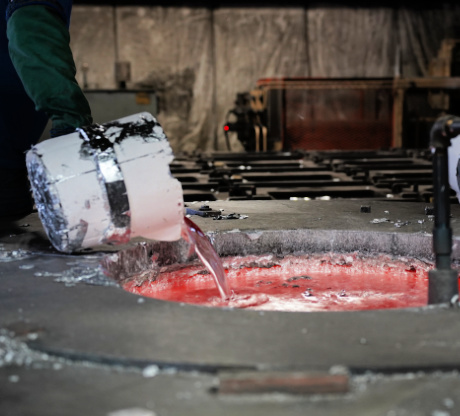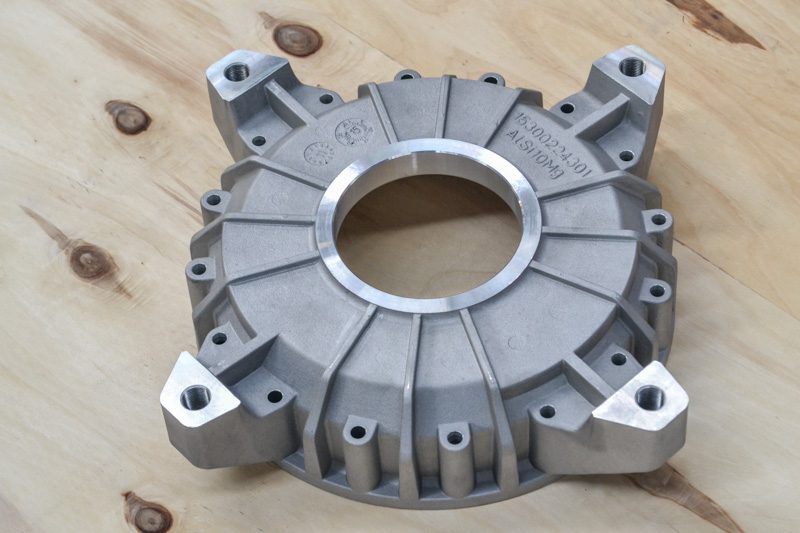Benefits of using Metal Castings in industrial design
Wiki Article
Exactly How Aluminum Foundry Contributes to Cutting-edge Solutions in Steel Fabrication
Aluminum foundries considerably influence the landscape of steel manufacture. They embrace advanced casting techniques that boost precision and design adaptability. This ability enables for the production of light-weight and resilient components that cater to varied sector demands. Additionally, the assimilation of automation and sustainable techniques establishes a benchmark for efficiency. As these factories advance, they increase inquiries regarding the future of production and the function of technology fit the sector.The Duty of Aluminum Foundries in Modern Production
Aluminum foundries play an essential role in contemporary production, adding considerably to various markets, including auto, aerospace, and consumer goods. These facilities specialize in the melting and spreading of aluminum, changing resources into high-grade components that satisfy stringent sector standards. The lightweight yet solid homes of Aluminum make it an ideal choice for manufacturers aiming to boost performance while lowering weight, particularly in the vehicle industry, where gas efficiency is paramount.Light weight aluminum shops use cutting-edge procedures to generate intricate shapes and layouts that provide to specific market demands. By leveraging sophisticated innovations such as computer-aided layout and simulation, these shops can enhance their manufacturing procedures and improve material usage. This not only improves the high quality of the final products but additionally reduces waste, adding to even more sustainable manufacturing practices. Ultimately, the contributions of Aluminum shops are essential for driving development and performance throughout multiple industries.
Advanced Spreading Techniques Changing Metal Fabrication
Advanced casting methods are revolutionizing the field of steel manufacture, especially via precision casting methods that improve precision and reduce waste. Cutting-edge alloy growths are also playing an essential function, allowing for personalized buildings and improved efficiency in various applications. With each other, these improvements are establishing new criteria in effectiveness and high quality within Aluminum factories.Precision Casting Methods
As the need for high-quality parts in different markets proceeds to rise, accuracy casting techniques have actually become a transformative pressure in steel construction. These strategies, including financial investment casting, shed foam casting, and die spreading, permit for detailed geometries and limited resistances that conventional methods frequently struggle to attain. By utilizing advanced products and innovations, accuracy casting reduces waste and improves efficiency, allowing suppliers to generate intricate components with decreased lead times. Furthermore, these techniques give exceptional surface finishes and mechanical homes, making them suitable for markets such as aerospace, automotive, and clinical devices. As manufacturers significantly take on precision casting, the ability to satisfy certain layout needs while maintaining cost-effectiveness comes to be a critical benefit in today's open market.Ingenious Alloy Dopes
Ingenious alloy developments are improving the landscape of steel fabrication, particularly within the domain name of precision spreading. Advancements in material science have caused the development of specialized Aluminum alloys that improve resistance, resilience, and strength to deterioration. These unique alloys allow shops to create elaborate components with boosted mechanical homes, catering to diverse industries such as aerospace, auto, and electronic devices. The consolidation of advanced spreading techniques, consisting of die spreading and sand casting, more maximizes making use of these products, enabling intricate geometries and minimized waste. Consequently, makers are much better equipped to satisfy rigid efficiency criteria while reducing ecological influence. Ultimately, these cutting-edge alloys are paving the way for a brand-new era of performance and sustainability in metal construction.Light-weight and Long Lasting: The Advantages of Aluminum Parts
Aluminum parts provide substantial advantages in numerous applications due to their light-weight nature and sturdiness. This combination adds to enhanced gas efficiency, especially in the auto and aerospace markets. Additionally, light weight aluminum's fundamental corrosion resistance additionally expands the life-span of items, making it a preferred choice in lots of steel manufacture procedures.Enhanced Fuel Efficiency
While traditional products have actually long been the standard in various markets, the change towards Aluminum parts is transforming the landscape of metal construction, specifically in relation to improved gas efficiency. Aluminum's lightweight nature significantly minimizes the overall weight of automobiles and equipment, enabling boosted efficiency and minimized power usage. This reduction in weight converts directly to reduced fuel intake, making Aluminum an eye-catching alternative for suppliers intending to fulfill rigorous environmental guidelines. In enhancement, light weight aluminum's durability guarantees that parts preserve their integrity gradually, contributing to long-term efficiency. As markets progressively prioritize sustainability, the adoption of Aluminum parts comes to be a strategic choice, straightening functional goals with environmental responsibility while boosting gas effectiveness in numerous applications.Corrosion Resistance Perks
One of the standout functions of Aluminum components is their phenomenal corrosion resistance, which considerably improves the long life and dependability of different applications. This residential or commercial property is particularly beneficial in harsh atmospheres, such as commercial and aquatic setups, where exposure to wetness and chemicals can cause significant destruction in other steels. Unlike steel, Aluminum normally forms a protective oxide layer that functions as an obstacle versus ecological components, lessening the danger of corrosion and rust. As a result, Aluminum elements need much less maintenance and have a longer life span, making them an economical selection for suppliers. This inherent resilience not only contributes to the overall efficiency of products yet additionally sustains sustainability initiatives by minimizing the need for regular replacements.Advancements in Design and Engineering With Aluminum Foundries
As developments in Aluminum Foundry modern technology remain to improve the landscape of steel manufacture, cutting-edge design and engineering options are arising to satisfy the demands of diverse markets. The versatility of Aluminum enables complex designs that were formerly unattainable with conventional materials. Shops are leveraging computer-aided layout (CAD) software application and simulation tools to optimize the design process, allowing designers to develop lightweight yet robust elements customized to certain applications.The capability to integrate sophisticated alloying techniques permits the personalization of Aluminum residential properties, boosting stamina and toughness. This flexibility fosters creative thinking in item growth, permitting firms to trying out brand-new forms and frameworks that enhance performance while minimizing weight. Collective initiatives in between factories and designers facilitate rapid prototyping, resulting in shorter project timelines and raised total effectiveness. These developments not only boost product performance yet also drive sustainability by reducing material waste during the manufacture procedure.
Enhancing Efficiency With State-Of-The-Art Technology
Innovations in state-of-the-art innovation are revolutionizing the performance of Aluminum shops, simplifying processes from style to production. Automation plays a pivotal function, with robotic systems improving the speed and accuracy of tasks such as molding, putting, and finishing. These automated remedies minimize human mistake and decrease labor prices, while likewise raising outcome uniformity.In addition, the assimilation of sophisticated software for computer-aided style (CAD) and simulation permits rapid prototyping and testing, expediting the change from idea to manufacturing. Shops are utilizing real-time information analytics to keep track of procedures, ensuring peak performance and minimizing downtime.
3D printing innovation is being taken on for creating complicated mold and mildews and elements, reducing material waste and lead times. The combination of these sophisticated technologies not only boosts performance yet additionally enhances the quality of Aluminum items, placing factories at the forefront of technology in metal construction.
Sustainable Practices in Aluminum Foundries
A growing variety of Aluminum shops are taking on lasting techniques to reduce their ecological impact and promote resource efficiency. Wisconsin Aluminum Foundry. These foundries are increasingly applying recycling programs, where scrap Aluminum is collected and recycled, greatly minimizing waste. Additionally, energy-efficient innovations, such as electric furnaces and advanced insulation materials, are being utilized to reduced energy usage during the melting processWater conservation strategies are also gaining grip, with many shops recycling water in cooling down systems to reduce general use. Furthermore, the adoption of environment-friendly layers and ingredients reduces damaging exhausts without compromising product high quality.
Future Fads in Aluminum Spreading and Metalworking
Significantly, the future of Aluminum casting and metalworking is being formed by technological developments and evolving sector requirements. Advancements in automation and robotics are simplifying processes, boosting precision, and reducing labor expenses. The adoption of additive production techniques, such as 3D printing, is transforming conventional casting methods, allowing for complex geometries and minimized material waste.Additionally, the integration of expert system and information analytics is enabling real-time tracking and predictive upkeep, which optimizes production performance. Sustainability stays a core focus, with companies purchasing green techniques, consisting of the recycling of Aluminum scrap and using sustainable energy resources in manufacturing.
As the demand for lightweight, resilient materials in different markets increases, Aluminum foundries need to adjust by developing ingenious alloys and boosting spreading techniques. These trends collectively direct to a future where Aluminum casting and metalworking are much more reliable, lasting, and responsive to market needs.

Frequently Asked Concerns
What Kinds Of Aluminum Alloys Are Frequently Made Use Of in Shops?
Generally made use of Aluminum alloys in factories consist of 2xxx series (copper), 3xxx series (manganese), 4xxx collection (silicon), 5xxx collection (magnesium), and 6xxx collection (magnesium and silicon), each offering one-of-a-kind properties appropriate for numerous applications.Just How Does Aluminum Spreading Compare to Other Metal Manufacture Methods?
Aluminum casting offers advantages such as reduced manufacturing expenses and complex shapes compared to traditional fabrication approaches. It supplies exceptional dimensional accuracy and surface area coating, making it a favored choice for lots of markets over choices like machining or welding.What Safety Actions Are Executed in Aluminum Foundries?
Aluminum factories carry out different safety actions, including personal safety devices, ventilation systems, normal security training, hazard assessments, and emergency situation procedures to secure employees from dangers related to molten metal, warm, and potential chemical exposure. Aluminum Foundry.Exactly How Can Business Discover Trusted Aluminum Foundry Allies?
Companies can recognize trustworthy Aluminum Foundry partners by evaluating market online reputation, assessing customer endorsements, appraising high quality qualifications, taking into consideration production capacities, and performing website sees to ensure placement with their certain needs and criteria.

What Is the Common Lead Time for Aluminum Casting Projects?
The normal preparation for Aluminum casting jobs ranges from two to eight weeks, depending on factors such as design complexity, production volume, and the foundry's capacity to meet specific task requirements and timelines.
Aluminum foundries play a vital role in modern production, adding click here considerably to different sectors, consisting of vehicle, aerospace, and consumer goods. As advancements in Aluminum Foundry modern technology proceed to improve the landscape of steel fabrication, innovative style and design options are arising to satisfy the demands of varied sectors. Improvements in cutting edge technology are revolutionizing the efficiency of Aluminum foundries, improving processes from design to production (Aluminum Castings). A growing number of Aluminum factories are embracing lasting methods to reduce their ecological impact and advertise source effectiveness. As the demand for lightweight, durable products in different sectors rises, Aluminum foundries must adapt by improving and developing cutting-edge alloys casting techniques
Report this wiki page